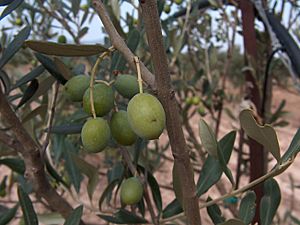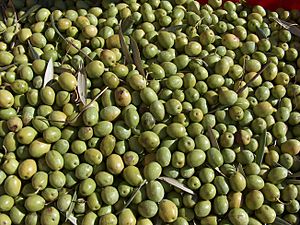Bosana facts for kids
Quick facts for kids Bosana |
|
|---|---|

Bosana olives
|
|
| Olive (Olea europaea) | |
| Color of the ripe fruit | Black |
| Also called | Olia di Ozzu, Palma |
| Origin | Spain |
| Notable regions | Sardinia |
| Hazards | Peacock butterfly |
| Use | Oil and table |
| Oil content | High |
| Fertility | Self-sterile |
| Growth form | Spreading |
| Leaf | Elliptic-lanceolate |
| Weight | 2.5–3 g |
| Shape | Slightly ovoid |
| Symmetry | Symmetrical |
The Bosana is the most common type of olive tree found in Sardinia, an island in Italy. More than half of all olives grown on the island are Bosana olives.
People aren't completely sure where the name "Bosana" comes from. It might be linked to a place called Bosa in Sardinia. However, many believe this olive type originally came from Spain. Bosana olives are mostly used to make olive oil, but you can also eat them. This olive tree is known for growing well even in tough environments.
Contents
Where Does the Bosana Olive Grow?
The Bosana olive is very common in the main olive-growing areas of northern and central Sardinia. These areas include Sassari, Nurra, Marghine, and Planargia. You can also find some Bosana olives in central southern Sardinia, especially in parts of the Province of Medio Campidano. This olive variety also grows in Montenegro.
Other Names for Bosana Olives
The Bosana olive is known by several other names. These names are often used for local types that are actually the same as Bosana. Some of these names include Palma, Aligaresa, Tonda di Sassari, and Olia de Ozzu. These are mostly local names for the same popular Bosana olive.
What Makes Bosana Olives Special?
The Bosana olive tree is a medium-sized tree. It has a wide, spreading shape and its leaves are oval-shaped with pointed ends. The tree's branches grow openly, creating an average-sized crown.
The olives themselves are medium weight, usually between 2.5 and 3 grams. They are slightly egg-shaped and look quite even on both sides. The pit inside the olive is smooth and rounded at the top. The skin of the olive has tiny spots called lenticels.
The olives start to ripen from the tip downwards. When they are fully ripe, they turn black. Bosana olives ripen in the middle to late part of the season. In the Medio Campidano area, they usually ripen between November and December.
How Are Bosana Olives Used?
The Bosana olive is mainly used to make olive oil. It gives a good amount of oil, usually about 17-18% of its weight. The oil tastes even better if the olives are picked early, right when they start to ripen. People describe the oil's taste as "fruity, bitter, and spicy."
Larger Bosana olives can also be eaten as table olives. They can be prepared when they are green or black. These olives are known for keeping their color well during processing.
Growing Bosana Olives
The Bosana olive tree is very productive. It grows well in olive groves where many trees are planted close together. It can even thrive in difficult growing conditions. This tree tends to produce a lot of olives one year and fewer the next. However, farmers can manage this by using good farming methods. These methods include adding fertilizer, providing water, and carefully pruning the trees.
Bosana olive trees usually need other olive varieties nearby to help them produce fruit. This is because they are "self-sterile," meaning they can't pollinate themselves. Some olive types used to help pollinate Bosana trees include Nera di Gonnos and Pizz'e carroga.
The Bosana olive tree is generally strong against most common plant pests. However, it can be affected by the peacock butterfly, especially in damp areas of northern and central Sardinia. It has an average resistance to the olive fruit fly. It is also very good at resisting heat, moths, and a type of bacteria called Pseudomonas savastanoi.


